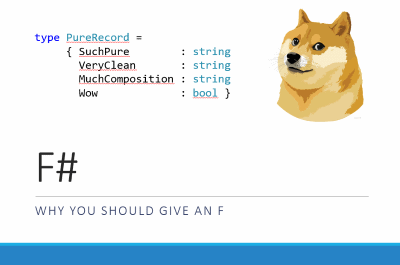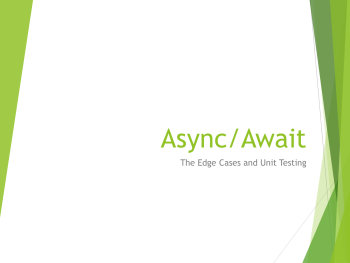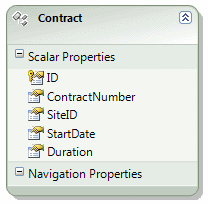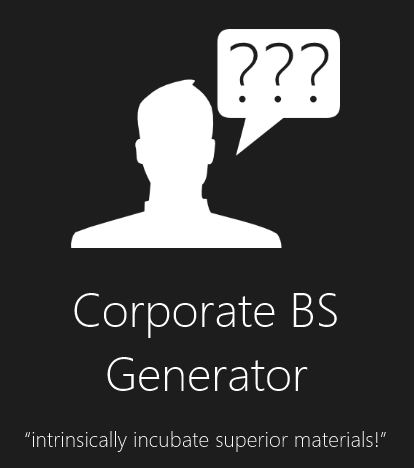Only showing posts tagged with ".NET"
F# - Why You Should Give an F (DDD Melbourne Presentation)
July 19, 2014 1:07 PM by Daniel Chambers

Today at DDD Melbourne I gave an introductory presentation on F#, .NET’s general purpose functional programming language.
The abstract for the talk is:
Are you a C# programmer that loves the power and fluency of libraries like LINQ and RX? Do you sometimes find it difficult to write your own expressive, clean, reliable and concurrent code? Have you looked at functional programming and been terrified by math symbols and scary sounding words like "monad" and "category theory"?
In this talk we'll introduce and discuss how to use F# and functional programming techniques to write that cleaner, more expressive and reliable code that you've always wanted; and we promise not to descend into crazy math symbols!
I’ve uploaded the source code and slides to a GitHub repository, so you can examine the awesome in your own time and get excited… in private. :)
I’ve also fixed the copy and paste bug that Mahesh pointed out on Twitter. Can’t let a little typo stand! :)
To compile the SQLClient type provider code, you’ll need to install the AdventureWorksLT sample database to your own SQL Server instance. You can download it from Codeplex under the name “AdventureWorksLT2012_Data”. You can follow this guide on how to attach the downloaded MDF file to SQL Server (why Microsoft don’t provide a .BAK file to restore instead, I don’t know!)
To get started coding in F#, I recommend the following tools:
- Visual Studio 2013 – Make sure you update the included “Visual F#” extension to the latest version
- Visual F# Power Tools Extension
- F# Outlining Extension
To learn more about F#, I highly recommend:
- F# For Fun and Profit – F# and functional programming explained in simple understandable language – no crazy maths stuff
- Try F# – Online syntax tutorials and in-browser compiler
- The F# Software Foundation – The F# community hub; has links to videos, guides and commonly used libraries
F# people to follow on Twitter (obviously not exhaustive!):
- Don Syme – The Benevolent Dictator for Life of the F# language (he is its designer)
- Tomas Petricek – Super F# enthusiast and founding member of the F# Foundation
- Scott Wlaschin – Scott is the author of F# For Fun and Profit
The Corporate BS Generator Windows 8 App
October 03, 2012 1:23 PM by Daniel Chambers (last modified on October 03, 2012 1:29 PM)
On my last gig my friend Mahesh sent the team a link to Tommy Butler’s simple Corporate BS Generator page, and naturally we all cracked up. For the whole day any chat over Skype was derailed with someone chucking in some random BS, for example “that’s a good idea, but does it conveniently enable visionary services?” It was a Windows 8 app gig, so we were all neck deep in WinRT and XAML, and it came to me that this would be awesome as an app for Windows 8.
Today, I’d like to announce the release of the Corporate BS Generator Windows 8 app on the Windows Store. Tommy has given me his blessing to bring the lulz to Windows 8 and Windows RT users.
Have you ever sat through a corporate presentation and been dazzled by fancy buzzword-filled phrases? Have you ever wished that you were capable of effortlessly making normal, typical and common-sense things sound slick, hip, modern and cool? The Corporate BS Generator can help you get ahead in an industry where spin, buzzwords and vagueness reign supreme.
Swipe or click your way through randomly generated Corporate BS and impress your executives at your next meeting. Your BS will sound so good that they’ll just nod enthusiastically even though they have no idea what your plan to “compellingly target future-proof synergy” actually means!
Here’s a sampling of some of the BS it generates:
- dynamically e-enable world-class solutions
- globally engage intuitive methodologies
- credibly transition ethical communities
- uniquely embrace progressive e-tailers
- dynamically productise orthogonal scenarios
- continually foster stand-alone supply chains
Cracked up yet? Grab the app from the Windows Store now.
Async/Await - The Edge Cases and Unit Testing Presentation
October 03, 2012 12:29 PM by Daniel Chambers

Tonight I gave a short presentation at Devevening titled “Async/Await – The Edge Cases and Unit Testing”. Here’s the abstract:
In this talk we'll look at the new async await feature in C# 5, but we'll go beyond the typical toy examples and look at edge cases like exception handling, task cancellation and how we can approach unit testing asynchronous methods.
I’ve uploaded the source code and slides to a BitBucket repository, so for those who want to inspect the examples at their own leisure, please clone away:
- Source code (specifically revision 394d1e3cf9f5 was used in this talk)
- Presentation slides
I hope to make an extended version of the talk and present that at a future user group; I’d like to cover things in a little more detail, look at the history of async over the life of the .NET Framework, cover unit testing a bit more thoroughly, and maybe even take a peek under the covers at what the compiler generates when you write an async method. Stay tuned!
Performing Date & Time Arithmetic Queries using Entity Framework v1
June 07, 2010 3:21 PM by Daniel Chambers (last modified on June 09, 2010 2:58 AM)
If one is writing legacy code in .NET 3.5 SP1’s Entity Framework v1 (yes, your brand new code has now been put into the legacy category by .NET 4 :( ), one will find a severe lack of any date & time arithmetic ability. If you look at LINQ to Entities, you will see no date & time arithmetic methods are recognised. And if you look at the canonical functions that Entity SQL provides, you will notice a severe lack of any date & time arithmetic functions. Thankfully, this strangely missing functionality in canonical ESQL has been resolved as of .NET 4; however, that doesn’t help those of us who haven’t yet upgraded to Visual Studio 2010! Thankfully, all is not lost: there is a solution that only sucks a little bit.
Date & time arithmetic is a pretty necessary ability. Imagine the following simplified scenario, where one has a “Contract” entity that defines a business contract that starts at a certain date and lasts for a duration:

Imagine that you need to perform a query that finds all Contracts that were active on a specific date. You may think of performing a LINQ to Entities query that looks like this:
IQueryable<Contract> contracts =
from contract in Contracts
where activeOnDate >= contract.StartDate &&
activeOnDate < contract.StartDate.AddMonths(contract.Duration)
select contract
However, this is not supported by LINQ to Entities and you’ll get a NotSupportedException. With canonical ESQL missing any defined date & time arithmetic functions, it seems we are left without a recourse.
However, if one digs around in MSDN, one may stumble across the fact that the SQL Server Entity Framework provider defines some provider-specific ESQL functions with which one can use to do date & time arithmetic. So we can write an ESQL query to get the functionality we wish:
const string eSqlQuery = @"SELECT VALUE c FROM Contracts AS c
WHERE @activeOnDate >= c.StartDate
AND @activeOnDate < SqlServer.DATEADD('months', c.Duration, c.StartDate)";
ObjectQuery<Contract> contracts =
context.CreateQuery<Contract>(eSqlQuery, new ObjectParameter("activeOnDate", activeOnDate));
Note the use of the SqlServer.DATEADD ESQL function. The “SqlServer” bit is specifying the SQL Server provider’s specific namespace. Obviously this approach has some disadvantages: it’s not as nice as using LINQ to Entities, and it’s also not database provider agnostic (so if you’re using Oracle you’ll need to see whether your Oracle provider has something like this). However, the alternatives are either to write SQL manually (negating the usefulness of Entity Framework) or to download all the entities into local memory and use LINQ to Objects (almost never, ever an acceptable option!).
Notice that using the CreateQuery function to create the query from ESQL returned an ObjectQuery<T> (which implements IQueryable<T>)? This means that you can now use LINQ to Entities to change that query. For example, what if we wanted to perform some further filtering that can be customised by the user (the user’s filtering preferences are set in the ContractFilterSettings class in the below example):
private ObjectQuery<Contract> CreateFilterSettingsAsQueryable(ContractFilterSettings filterSettings, MyEntitiesContext context)
{
IQueryable<Contract> query = context.Contracts;
if (filterSettings.ActiveOnDate != null)
{
const string eSqlQuery = @"SELECT VALUE c FROM Contracts AS c
WHERE @activeOnDate >= c.StartDate
AND @activeOnDate < SqlServer.DATEADD('months', c.Duration, c.StartDate)";
query = context.CreateQuery<Contract>(eSqlQuery, new ObjectParameter("activeOnDate", filterSettings.ActiveOnDate));
}
if (filterSettings.SiteId != null)
query = query.Where(c => c.SiteID == filterSettings.SiteId);
if (filterSettings.ContractNumber != null)
query = query.Where(c => c.ContractNumber == filterSettings.ContractNumber);
return (ObjectQuery<Contract>)query;
}
Being able to continue to use LINQ to Entities after creating the initial query in ESQL means that you can have the best of both worlds (forgetting the fact that we ought to be able to do date & time arithmetic in LINQ to Entities in the first place!). Note that although you can start a query in ESQL and then add to it with LINQ to Entities, you cannot start a query in LINQ to Entities and add to it with ESQL, hence why the ActiveOnDate filter setting was done first.
For those who use .NET 4, unfortunately you’re still stuck with being unable to do date & time arithmetic with LINQ to Entities by default (Alex James told me on Twitter a while back that this was purely because of time constraints, not because they are evil or something :) ). However, you get canonical ESQL functions that are provider independent (so instead of using SqlServer.DATEADD above, you’d use AddMonths). If you really want to use LINQ to Entities (which is not surprising at all), you can create ESQL snippets in your model (“Model Defined Functions”) and then create annotated method stubs which Entity Framework will recognise when you use them inside a LINQ to Entities query expression tree. For more information see this post on the Entity Framework Design blog, and this MSDN article.
EDIT: Diego Vega kindly pointed out to me on Twitter that, in fact, Entity Framework 4 comes with some methods you can mix into your LINQ to Entities queries to call on EF v4’s new canonical date & time ESQL functions. Those methods (as well as a bunch of others) can be found in the EntityFunctions class as static methods. Thanks Diego!

